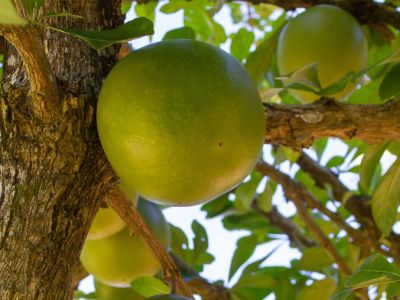Calabash Tree Information
The calabash tree has a broad, irregular crown with wide, spreading branched. The leaves are two to six inches (5 to 15 cm.) long. Orchids grow in the bark of these trees in the wild. Calabash tree facts indicate that the tree’s flowers, each about two inches (5 cm.) wide, are cup-shaped. They seem to grow directly from the calabash branches. They only bloom at night and emit a slight odor. By noon of the following day, the flowers wilt and die. The calabash tree flowers are pollinated by bats during the night. In time, the trees produce the round fruit. These large fruits take six months to ripen. Calabash tree facts make clear that the fruits are not edible to humans but they are used for a variety of ornamental purposes. For example, the shells are used to make musical instruments. Horses, however, are said to crack open the hard shells. They eat the fruit without detrimental effect. Black calabash trees (Amphitecna latifolia) share many of the same characteristics of the calabash and are from the same family. They grow to about the same height, and produce leaves and flowers that resemble those of the calabash. The black calabash fruits, however, are edible. DO NOT confuse the two trees.
How to Grow a Calabash Tree
If you are wondering how to grow a calabash tree, the trees grow from the seeds inside the fruit. The shell of the fruit is surrounded by pulp in which the brown seeds are located. Plant the seeds in almost any type of soil, and be sure to keep the soil moist. The calabash tree, whether a seedling or a mature specimen, cannot tolerate drought. A calabash tree can only be planted in areas without frost. The tree cannot tolerate even the lightest frost. It thrives in U.S. Department of Agriculture plant hardiness zones 10b through 11. Calabash tree care includes providing regular water to the tree. Be careful if planting a calabash near the sea, as it has no salt tolerance.
